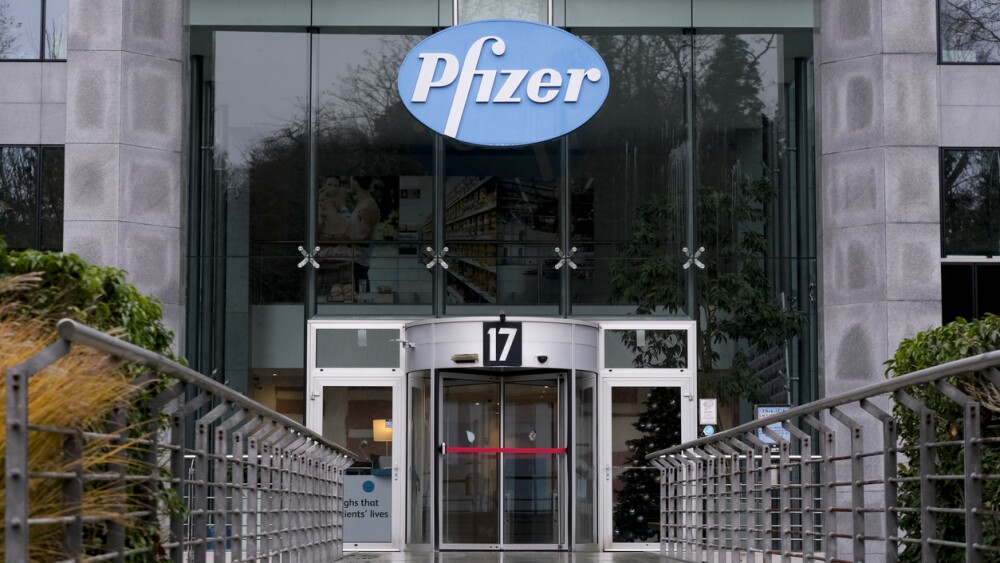BERKELEY, Calif., Oct. 4 /PRNewswire-FirstCall/ -- The NEW ENGLAND JOURNAL OF MEDICINE (Vol. 355, October 5, 2006, No.14), today reported that a new approach to allergy therapy not only reduced the acute allergic responses of individuals with ragweed allergies but also sustained that effect for over 12 months. The novel treatment, called "AIC" in the paper, is a TLR9 agonist linked to ragweed allergen, developed by Dynavax Technologies Corporation .
Dr. Peter Creticos, principal investigator and lead author of the paper, entitled, "Immunotherapy with a Ragweed-Toll-like Receptor 9 Agonist Vaccine for Allergic Rhinitis," said that the pilot study "appears to offer a means of achieving long-term clinical efficacy in ragweed allergic rhinitis as the clinical effects suggest the induction of long-lasting disease modification. Furthermore, the demonstrated therapeutic properties and safety pave the way for a therapeutic intervention that is qualitatively superior to standard immunotherapy." Dr. Creticos is Associate Professor of Medicine and Clinical Director of the Division of Clinical Immunology of The Johns Hopkins University School of Medicine. He serves as Medical Director of the Johns Hopkins Asthma and Allergy Center in Baltimore, Maryland.
In the paper, Dr. Creticos pointed to statistically significant efficacy results including peak Nasal Symptom Complex Score (NSCS) reductions in AIC-treated patients of 55% (p=0.03) in 2001 which persisted through the 2002 ragweed season (53% reduction in NSCS, p=0.02) with no additional therapy. Additionally, the AIC-treated group used no relief medication at all during the second season, while placebo patients used antihistamines for 8 days (average) and decongestants for 4 days (average) of the two-week peak season. The intervention also generated clinically significant quality of life improvements for patients. Dr. Creticos added that the intervention was safely tolerated as no treatment-associated serious adverse reactions were reported, nor did any lab tests show abnormalities in the patients tested.
With funding from the National Institute of Allergy and Infectious Diseases and the Immune Tolerance Network, and the study drug provided by Dynavax, Dr. Creticos conducted a blinded, randomized, placebo-controlled, clinical trial in 25 ragweed allergic patients beginning in May 2001 and concluding in October, 2002. Patients were treated with either the drug or placebo, using a 6-injection regimen, prior to the first ragweed season, and were followed for two years. Dynavax supplied the study drug, now known as TOLAMBA(TM), and contributed to trial design, but did not participate in data accrual, analysis, or funding of the trial. TOLAMBA, consisting of a TLR9 agonist linked to a specific ragweed allergen, is currently being evaluated in late-stage clinical trials for the treatment of allergic rhinitis.
DYNAVAX Clinical Trials Update
In the paper, Dr. Creticos recommends additional large-scale studies, which are now underway at Dynavax. Since the reported study's initiation in 2001, Dynavax has generated a substantial amount of data in 14 clinical trials in the U.S., France, and Canada. More than 7,000 TOLAMBA injections have been administered to over 1,100 patients. In these trials, TOLAMBA was shown to be safe and well tolerated, to provide measurable improvements in allergy symptoms, and to reduce medication use.
TOLAMBA consists of 1018 ISS, a TLR9 agonist, linked to the purified major allergen of ragweed, called Amb a 1. The linking of ISS to Amb a 1 ensures that both ISS and ragweed allergen are presented simultaneously to the same immune cells, producing a highly specific and potent effect suppressing the Th2 cells responsible for inflammation associated with ragweed allergy. Moreover, this treatment reprograms the immune response away from the Th2 response and toward a Th1 memory response so that, upon subsequent natural exposure to the ragweed allergen, long-term protection is achieved.
Other Clinical Results; Trial Background
A Dynavax-funded, 30-center, placebo-controlled study in 738 ragweed allergic subjects, aged 18 to 55 years, is expected to produce interim data at one-year in the first quarter of 2007. The study known as "DARTT" (Dynavax Allergic Rhinitis TOLAMBA Trial) randomized subjects into three arms: the same dosing regimen that was used in the completed Phase 2/3 trial; a higher total dose regimen; and placebo. Subjects received six doses over six weeks prior to the start of the 2006 ragweed season. Ragweed symptoms were followed over the 2006 ragweed season and will also be followed through the 2007 season. The primary endpoint is reduction in total nasal symptom scores (TNSS) during the second (2007) peak ragweed season. Dynavax anticipates that data from the DARTT interim analysis, if positive, combined with the safety and efficacy data from the recently completed two-year Phase 2/3 trial, and from an ongoing trial in ragweed allergic children, could provide sufficient patient data for determining the potential timeline to registration for the intervention.
Additionally, Dynavax is evaluating TOLAMBA in a three-year, 19-center, pediatric trial with over 300 patients, ages six to 15 years. The primary endpoint of the study is reduction in TNSS during the 2006 peak ragweed season; a key secondary endpoint is the prevention of progression to asthma. The study was initiated in early 2005. Primary endpoint data for the study is expected in early 2007.
In January 2006, Dynavax announced that results from a two-year Phase 2/3 clinical trial of TOLAMBA showed that patients treated with TOLAMBA experienced a statistically significant 28.5% reduction in total nasal symptom scores (TNSS) compared to placebo-treated patients in the second year of the trial (p=0.024). Results also showed significant clinical benefit relative to secondary endpoints, including composite hay fever symptoms and ocular effects, and a significant reduction in antihistamine use (p=0.01). These results were achieved after a single short course of therapy prior to the first ragweed season (2004), and demonstrated that a booster dose prior to the second season (2005) was not required to achieve clinical benefit. The safety profile of TOLAMBA was favorable; systemic side effects were indistinguishable from placebo and local injection site tenderness was minor and transient.
TOLAMBA represents the foundation of a comprehensive allergy franchise for Dynavax, and has the potential to be a novel entrant in the multibillion- dollar global allergy market. In the U.S. alone, approximately 40 million people suffer from allergic rhinitis. Ragweed is the single most common seasonal allergen, affecting up to 75% of those with allergic rhinitis, or 30 million Americans. Current therapeutic options are mainly limited to symptomatic therapies and conventional allergy immunotherapy, which generally requires 60-90 shots over three to five years and represents a significant treatment burden for allergy sufferers. Dynavax believes that TOLAMBA has the potential to become the first of several new and important disease-modifying therapeutic options for patients and physicians.
About Dynavax
Dynavax Technologies Corporation discovers, develops, and intends to commercialize innovative TLR9 agonist-based products to treat and prevent allergies, infectious diseases, cancer, and chronic inflammatory diseases using versatile, proprietary approaches that alter immune system responses in highly specific ways. Our clinical development programs are based on immunostimulatory sequences, or ISS, which are short DNA sequences that enhance the ability of the immune system to fight disease and control chronic inflammation. Dynavax's pipeline includes: TOLAMBA, a ragweed allergy therapeutic, for which a major safety and efficacy trial (DARTT) is currently underway, and that is in a supportive clinical trial in ragweed allergic children; HEPLISAV(TM), a hepatitis B vaccine in Phase 3; and a therapy for non-Hodgkin's lymphoma in Phase 2. Its preclinical asthma and COPD programs are partnered with AstraZeneca. Funding for the company's other preclinical programs in cancer, hepatitis B and hepatitis C therapies, and for an influenza vaccine have been provided by Symphony Dynamo and NIH, and represent future partnering opportunities. Preliminary data from the study published today in the NEJM were previously reported at the AAAAI 2003 annual meeting. For more information, please visit www.dynavax.com .
This press release contains forward-looking statements that are subject to a number of risks and uncertainties, including statements about our clinical development plans and timelines, business plans, future operating results, intellectual property position and potential sources of funds. Actual results may differ materially from those set forth in this presentation due to the risks and uncertainties inherent in our business, including difficulties or delays in development, achieving the objectives of our collaborative and licensing agreements and obtaining regulatory approval for our products; the scope and validity of patent protection for our products; competition from other companies; our ability to obtain additional financing to support our operations; and other risks detailed in the "Risk Factors" section of our Annual Report on Form 10-K and Quarterly Report on Form 10-Q. We undertake no obligation to revise or update information herein to reflect events or circumstances in the future, even if new information becomes available.
Dynavax Technologies CorporationCONTACT: Shari Annes, Corporate Communications, Dynavax TechnologiesCorporation, +1-650-888-0902, or sannes@dvax.com
Web site: http://www.dynavax.com/




